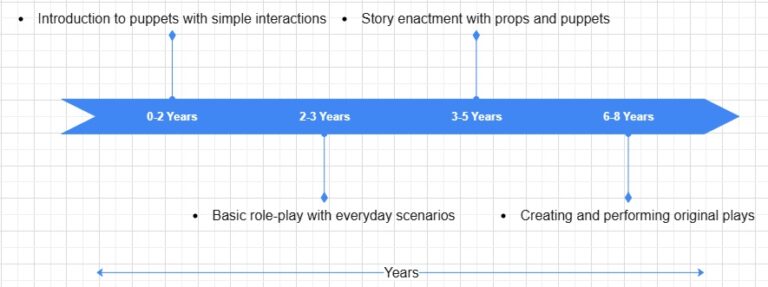
Introduction
Drama and puppetry help a child to express emotions and develop storytelling and communicative abilities. Pupils also learn through role-playing or using puppets to sort out their feelings and interact appropriately in peer groups. These activities foster teamwork and an understanding of fellow people, making drama advantageous for the complete development of a learner.

Theoretical Perspectives
Piaget’s Theory: Jean Piaget gave much emphasis on what he termed as symbolic play in critical cognitive development. He thought that dramatic play, including role play, gestures, or the use of puppets, helps children understand their environment and develop powers of abstraction (Rabindran & Madanagopal, 2020).
Erikson’s Theory: Erik Erikson’s psychosocial development theory highlights the importance of role play in the development of an individual’s identity. For example, playing dress-up as a doctor or teacher allows children to try on social roles and understand the feelings associated with those roles (Paul, 2023).
| Theory | Focus |
| Piaget’s Theory | Symbolic play fosters imagination. |
| Erikson’s Theory | Role-play aids emotional growth. |
Resources, Materials, and Digital Technologies
Dramatic play thrives on both physical and digital resources, as well as creative recycling.
- Physical Materials: Puppets, dolls, mascots, costumes, toy doctor bags.
- Digital Tools: Applications such as Puppet Pals and Toonastic for creating animated stories.
- Recycled Resources: Sock puppets made using cards, small theatre backgrounds made from cardboard.
| Resource Type | Examples |
| Physical | Puppets, costumes |
| Digital | Storytelling apps |
| Recycled | Sock puppets, cardboard |
Learning Experiences
0–2 Years: Learn animals and their simple vocalizations to establish communication skills in infants, using animal puppets. For example, a lion’s puppet that produces “roar” sounds helps children understand cause and effect relationships.
2–3 Years: Teach toddlers to perform family-related role play where they mimic everyday activities such as cooking or going shopping. This is particularly beneficial for language and communication, as well as motor skills.
3–5 Years: Children can reproduce theatrical stories like “The Three Little Pigs,” using voice modulation and teamwork to enhance creativity.
6–8 Years: Older children can write and act out their own short plays, make and wear costumes, and learn creative writing, cooperation, and public speaking in the process.
Original Creative Learning Opportunity
Activity: Puppet storytelling for children aged 3 to 5 years.
Children can create sock puppets using old socks, buttons, and fabric scraps, which can be easily obtained from recycled materials. They then perform a short, easy narrative, such as “Goldilocks and the Three Bears,” with an emphasis on dialogue and facial gestures.

Critical Reflection and Evaluation
The qualification, advocacy, passion, and interest in early childhood drama and puppetry, combined with personal creative characteristics such as storytelling and role play, will significantly enhance creativity, creative thinking, and innovation. I am particularly interested in using drama to express emotions and allow children to explore different roles while analyzing different perspectives within a story. Puppet storytelling or family role-playing allows me to demonstrate how one can adapt to new characters and think critically about a story. This does not only enhance the innovative competence of the learner but also their social-emotional development. My multicultural orientation in enjoying and embracing different cultural stories will guide how I present characters and plots that children can explore, inspiring them to come up with creative ideas in society. Additionally, I am prepared to guide children in creating with technology, for example, using applications for interactive storytelling. This will enable them to reason and innovate on how information and stories can be conveyed through media.